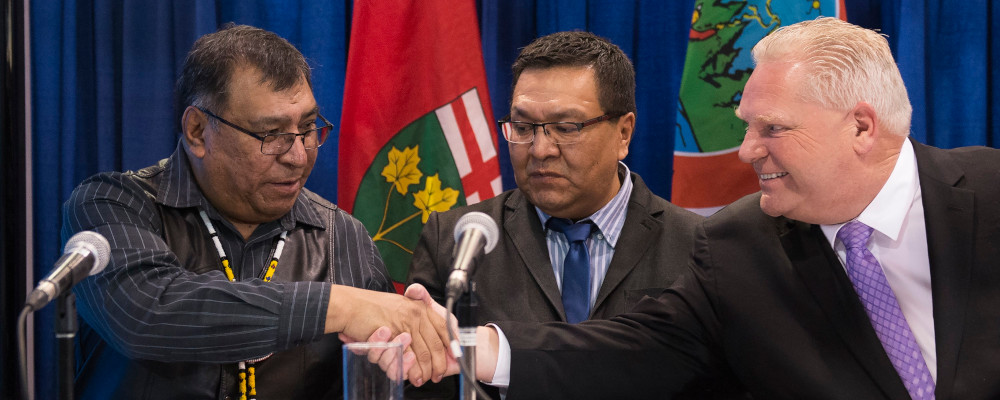With the legal implementation of the United Nations Declaration on the Rights of Indigenous Peoples in Canada, a paradigm shift is underway around how governments and industry successfully advance natural resource and energy infrastructure projects on First Nation lands and in our traditional territories. Major projects that impact our lands must be designed, built, operated, and decommissioned in a good way. Free, prior, and informed consent cannot be an afterthought.
The Government of Canada’s latest commitment to launch a loan guarantee program that supports Indigenous equity participation in major natural resource projects is a significant shift in these respects. First Nations can leverage the new program to participate meaningfully as architects of Canada’s economic and energy futures.
For far too long, the inability to access competitively priced capital to make equity investments in major projects has sidelined First Nations from receiving a fair share of the economic returns from natural resource and energy infrastructure projects developed in our backyards. Systemic barriers that historically discriminated against First Nations, such as the Indian Act, persist today and prevent us from participating equitably in Canada’s economy.

These barriers are responsible for why the narrative around First Nation economic participation has been about redress and compensation instead of partnership and shared prosperity.
We deserve to be recognized as strategic business partners when it comes to protecting our rights and interests and making sure that our communities benefit meaningfully. It should go without saying that trust, collaboration, and respect are valuable.
The issue is that many of our Nations lack the financial resources for investing in major projects and cannot access competitively priced capital needed for financing larger investments. In most cases, our Nations must borrow 100 percent of our equity investment in the form of an “equity loan,” which causes lenders to charge higher rates that approach the expected return on equity and eats away whatever remains for us as shareholders.
The alternative is accepting a smaller position or nothing at all, which are all-too-familiar realities for First Nations across the country. But we want to participate as equity investors and owners. Our respective First Nations are actively negotiating ownership stakes in projects like wind farms, geothermal power, transmission lines, and mines.
The forthcoming Indigenous Loan Guarantee Program therefore presents an unprecedented opportunity to reshape the landscape of Canada’s natural resource sector by enabling First Nations to participate as owners of major natural resource and energy infrastructure projects. Canada’s road to its net-zero emissions target runs through our lands and fostering new opportunities for First Nation equity participation will make the journey smoother.
As demonstrated by the programs in Ontario and Alberta, loan guarantees reduce the cost of borrowing for First Nations and therefore help to make equity investment more accessible and affordable. So far, the two provincial programs have unlocked $1.5 billion in equity investments and created long-term revenue streams for more than 50 First Nations. Looking to these programs as models for the federal program would be wise.
From our perspective, the new federal program should be sector-agnostic. Starting in the natural resource sector makes sense, but the economic opportunities facing First Nations vary widely and there is no good reason to exclude projects in other sectors, such as telecommunications, real estate, or public infrastructure. Even within the natural resource sector, we recommend taking a flexible approach that accommodates different projects.

First Nations in the West do not have the same sectoral investment opportunities as First Nations in the East or up North. For the very same reasons, the Government of Canada should approach risk on a project-by-project basis and program officials should have a mandate to entertain loan guarantees at all stages of a project or asset’s lifecycle, from design to decommissioning. First Nations will also require capacity support for conducting due diligence or seeking advice around corporate structuring—standard practices for any commercial transaction.
As we prepare for discussions with federal officials and political staff, we carry the mandate of our First Nations members back home to secure meaningful opportunities for economic participation and a leadership role that respects our autonomy and relationships with the land.
An Indigenous loan guarantee program could be more than a financial instrument. By harmonizing economic development with Indigenous stewardship, the government of Canada has an opportunity to usher in a new era of partnership that benefits all Canadians.
We urge the Government of Canada to seize this momentous opportunity by standing up the Indigenous loan guarantee program in this year’s budget.
Recommended for You

‘The provinces want some carrots’: Sean Speer on what will come of the prime minister’s meeting with Canada’s premiers

‘It’s more about frustration than alienation’: Jason Kenney on Alberta separatist sentiments and what this means for Canada

Need to Know: Three cheers for Canada’s entrepreneurs and executives

‘Let’s focus on leading the federation, not leaving it’: Jason Kenney on the Alberta separatist movement and the state of conservatism in Canada



